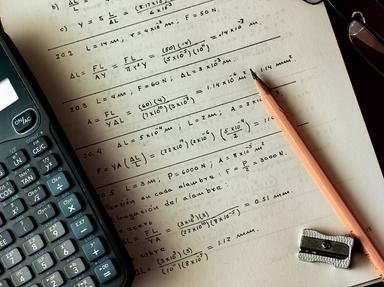Quiz Answer Key and Fun Facts
1. Harder graphs of real functions
What is the equation of the horizontal asymptote of the function x^2/(x^2-9)?
2. Circle Geometry
The cyclic quadrilateral ABCD lies inside a circle. The line BC is extended to the point E, creating the line BE and the exterior angle DCE. Angle DCE is equal to which interior angle of the quadrilateral?
3. Further trigonometry
In first quadrant, if sinx = 4/7, then what is the exact value of sin(2x)?
4. Angle between two lines
What is the size of the angle between the two lines 3x-2y+1=0 and x-3y=0 (answer in degrees and minutes)
5. Dividing an interval
The point P(x,y) divides A(6,-2) and B(-7,5) internally in the ratio 3:4. What are the values of x and y?
6. Parametric equations
What is the equation of the normal to the parabola x^2=4ay at the point P(2ap,ap^2)?
7. Polynomials
If a polynomial function has a zero from a cubic factor, what happens to the function when it reaches the x-axis at that point? Pick the MOST SPECIFIC answer that applies.
8. Iteration methods
By using x=4.5, what is the approximation for the positive root of the function
x^2-4x-1 when Newton's method is applied once?
9. Integration by substitution
Using the substitution u=x^2-1, what is the value of the integral of
2xsqrt(x^2-1)dx from x=1 to x=2?
10. Integration of sin^2(x) and cos^2(x)
What is the integral of sin^2(x)cos^2(x)dx?
11. Inverse Functions
If the function f(x)=x^2-4x has a restricted domain of x>2, then what is the inverse function of f(x)?
12. Inverse trigonometric functions
The curve y=3/(sqrt(x^2+4)) is rotated about the x-axis between x=0 and x=2. What is the volume of solid generated? (in units^3)
13. Permutations and Combinations
How many 6 letter words can be formed using the letters of the word PRESSES?
14. Rates involving multiple variables
A spherical metal ball is heated so that its radius is expanding at the constant rate of 0.04mm/second. At what rate will its volume be increasing when the radius is 3.4mm? (in mm^3/sec)
15. Harder exponential growth and decay
In a certain town, the growth in population is given by N=125+Ae^kt. If the population is initially 25650 and after 5 years is 31100, what is the population after 8 years?
16. Rectilinear Motion
The acceleration of a particle is given by a=6x^2-4x-3, where x is the displacement. What is the exact velocity when the particle is 2cm from the origin if initially, the particle is at the origin and has velocity 3cm/s?
17. Simple Harmonic Motion
A particle moves in a straight line with acceleration given by a=-16x. If initial displacement is 3m and initial velocity is 12m/s, what is the equation of the displacement of the particle over time t?
18. Binomial Theorem
The sum of the coefficients of (a+x)^n is always equal to what?
19. Projectile Motion
Which equation represents the greatest height of a projectile?
20. Binomial Probability
If I throw 5 dice in a game of Yahtzee, what is the probability of throwing 3 sixes?
Source: Author
dialga483
This quiz was reviewed by FunTrivia editor
rossian before going online.
Any errors found in FunTrivia content are routinely corrected through our feedback system.
